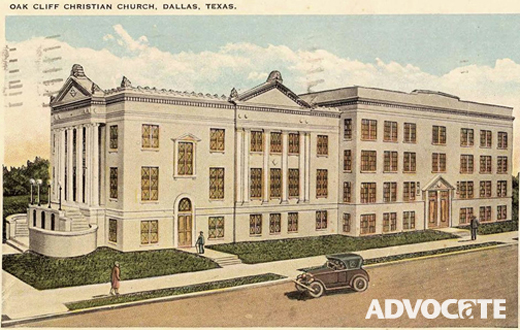In its glory days, Tenth Street held the record for churches per mile
Oak Cliff has wonderful houses of worship peppered all over our neighborhood. But in earlier days, there was only one main “ecclesiastic avenue” around: Tenth Street.
This 3-mile strip of pavement from the east end of Tenth westward, nearly to Hampton Road, held the record in “Ripley’s Believe It or Not” for having more churches per mile, on a street, than any other place in the world. And not surprisingly, quite a number of additional congregations “almost” anchored Tenth — setting either one block north or one block south.
The Father of Oak Cliff, Thomas Marsalis, envisioned his community as a spiritual utopia, populated by only the best pioneer folk. Analyzing the earlier La Reunion settlement failure to be the result of the absence of churches, Marsalis worked fervently to establish them.
What is now Oak Cliff United Methodist Church held successful revivals in 1891 and 1907, with Oak Cliff Christian Church holding an “outdoor” revival in 1909. The new pastor of Memorial Baptist Church (now Cliff Temple) held a successful weeklong service at Reagan Public School on Ninth Street that same year. Throughout these early days, other denominations followed suit and founded churches in the community — most of them ending up on or adjacent to Tenth Street.
More than 28 churches called Tenth Street home at some point, but as they moved and merged and the holy dust settled, 18 of those congregations anchored along Tenth Street’s perimeters. Among them are Cliff Temple Baptist Church, which in 1939 held the title of the second largest Southern Baptist church in the world (second only to First Baptist Dallas). Similarly, Tyler Street Methodist Church in 1950 took the honor of having the largest Sunday school enrollment in all of Methodism. Yes, right here in Oak Cliff!
Our community earned the title “Land of Churches,” as it was highly touted that more than 300 houses of worship were located in Oak Cliff — said to be the nation’s largest concentration of churches per square mile.
Tenth Street ran parallel to Jefferson Boulevard (which at the time was the largest commercial thoroughfare in the Southwest outside of a downtown business district). Hundreds of Tenth Street parishioners were able to take advantage of an inexpensive but efficient transportation option by traveling to and from church via the Jefferson Boulevard streetcar line.
Everything worked well, as long as the streetcar was king, and before a series of zoning changes and the 1950s alcohol ban in Oak Cliff. Then came the post-baby boom. Boomer families grew, causing more and more Cliffites to relocate to the burbs. And … things changed.
The good news? With more 1960s families able to afford a second car, and with more teenagers having their own wheels in the 1970s, it became easy to get to church independently, replacing the former need for public transportation. The bad news? Simply put, there weren’t enough parking spaces to accommodate the growing number of vehicles.
As a result of the Cliffite migration both south and southwestward, a slew of new churches sprang up — away from Oak Cliff’s center — and before long the Tenth Street temples found their congregational rolls decreasing. Although several congregations simply packed up and relocated, quite a few remained. And other churches managed to find a leveling-off place and have survived well despite the challenges. Some have refocused their ministries and thus discovered new life.
Some congregations have established schools, some have community ministries, some support Spanish and other foreign language services on their campuses, and others are researching new ways to use their large-but-aging buildings. In many cases, memberships are up, and so is the enthusiasm.
The life-altering experiences from yesteryear, the ones that took place in one of Tenth Street’s earlier houses of worship, will never be forgotten, especially to those who were there — and for those who hear their stories. But undoubtedly, the remaining, stalwart “Church Street” congregations are as dedicated to their current missions as were those early pioneers. Now, with new people moving into the neighborhood, Oak Cliff churches and the faith walks they share are still changing lives. And these folks will have their own stories to tell.
Will the former glory days ever return to Tenth Street? It doesn’t seem likely. But the remaining congregations do have fresh visions and renewed hope. And hope springs eternal …
See you in church!





